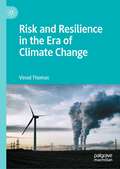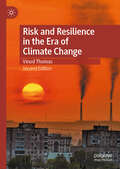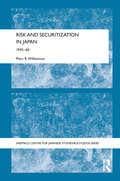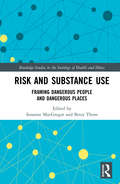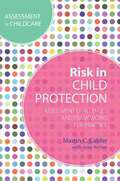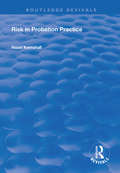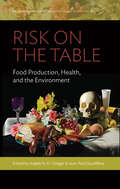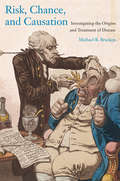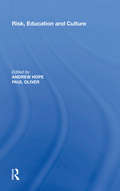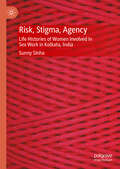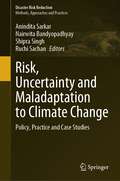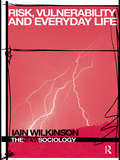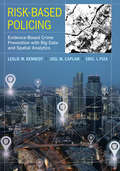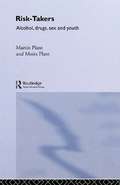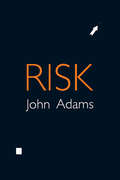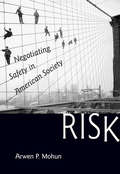- Table View
- List View
Risk and Public Policy in East Asia
by Mutsuko TakahashiContemporary Asian society is marked by social processes associated with the loss of stable economic growth and high employment; family structures capable of caring for family members in need; and governmental economic and political competence. Post-financial crisis job uncertainty and income and labor market polarization have become important issue in Asian societies. Family structures are viewed as have been weakened, with a corresponding rise in divorce and domestic violence. Trust in the government is in decline. Against this backdrop it is timely to review three critical issues: 1) policies addressing work-related risks and socio-economic security; 2) changes regarding the structure and stability of families; and 3) issues concerning governance in times of weakened state capacity, declining trust, and the emergence of new politics. Containing chapters written by international scholars, this book introduces the concepts and theoretical approaches of risk and risk and governance and places them within the context of Asian societies.
Risk and Reliability Analysis: Theory and Applications
by Paolo GardoniThis book presents a unique collection of contributions from some of the foremost scholars in the field of risk and reliability analysis. Combining the most advanced analysis techniques with practical applications, it is one of the most comprehensive and up-to-date books available on risk-based engineering. All the fundamental concepts needed to conduct risk and reliability assessments are covered in detail, providing readers with a sound understanding of the field and making the book a powerful tool for students and researchers alike. This book was prepared in honor of Professor Armen Der Kiureghian, one of the fathers of modern risk and reliability analysis.
Risk and Resilience in Childhood: An Ecological Perspective
by Mark W. Fraser"Literature is replete with stories of children who recover against impossible odds. No less dramatic are real-life accounts in social work case files. But why are some children so resilient when others are not? How can social work practice appropriate these positive forces on behalf of more children? This book takes a major leap forward from other social work texts to probe not only risk but resilience and the protective factors that promote positive developmental outcomes. Firmly research based, it bridges the gap between ecological theory and strengths-based practice and provides a foundation for developing case-specific interventions. <P><P>Building on the concepts and models articulated so expertly in the best-selling first edition, the authors of Risk and Resilience, 2nd Edition introduce a framework and interdisciplinary language for understanding and conceptualizing social and health problems of children and their families. Readers will easily draw implications for practice from its clear and organized presentation. Using an ecological and multisystems perspective, each chapter examines risk and protective factors for specific social problems and disorders in childhood, including drug abuse, school failure, adolescent pregnancy, and delinquency. <P><P> This book is a compelling and rich resource for practitioners, scholars, and educators.Special Features * Summarizes and distills for social work practice the latest research on risk factors for childhood problems. * Devotes a full chapter to suicidal behaviors among youth. * Describes how to tailor interventions on the basis of race, ethnicity, gender, and sexual orientation."
Risk and Resilience in the Era of Climate Change
by Vinod ThomasThis book presents essential insights on the interaction between rising risks and raising the bar for resilience during the climate crisis. Its timeliness lies in applying important findings on risk and resilience to runaway climate change. When risk and resilience are brought together in the context of climate catastrophes, three key messages emerge.The first is that accounting for the root causes of these calamities, and not just their symptoms, is essential to slowing the spike in these events. It is therefore vital to link carbon emissions from human activity to the sharp rise in climate disasters globally. The second is that growth economics and policy must factor in the failure of governments and businesses to tackle spillover harm from economic activities, as seen dramatically with global warming. With climate risks rising, this calls for a fundamental revision in the teaching and practice of business and economics. And third, prevention must become a far bigger part of resilience building, with greater preparedness for more intense destruction built into interventions. This emphasis on prevention deems disaster recovery as not just returning to how things were but building back better.
Risk and Resilience in the Era of Climate Change
by Vinod ThomasThis book presents essential insights on the interaction between rising risks and raising the bar for resilience during the climate crisis. Its timeliness lies in applying important findings on risk and resilience to runaway climate change. When risk and resilience are brought together in the context of climate catastrophes, three key messages emerge. The first is that accounting for the root causes, and not just their symptoms, is essential to slowing these events. It is therefore vital to link carbon emissions from human activity to the sharp rise in climate disasters globally. The second is that growth economics and policy must factor in the failure of governments and businesses to tackle spillover harm from economic activities, as seen strikingly with global warming AND BIODIVERSITY LOSS. With climate risks rising, this calls for a fundamental revision of the framing of growth in the teaching and practice of business and economics. And third, prevention must become a far bigger part of resilience building, with preparedness to avert or handle tougher eventualities built into interventions. Emphasis on prevention deems disaster recovery as not just returning to how things were but building back better.
Risk and Securitization in Japan: 1945-60 (The University of Sheffield/Routledge Japanese Studies Series)
by Piers R. WilliamsonSince the early 1990s, there has been an emphasis in international relations theory on the shift from a Cold War rationality of ‘threat’, to a post-Cold War rationality of ‘risk’. However, in Risk and Securitization in Japan, 1945-1960, Piers R. Williamson argues that this assumption of a shift in rationality stems from a fundamental failure to distinguish between the concepts of threat and risk. By clarifying the concepts of threat and risk, this book challenges the prevailing hypothesis of a shift from threat to risk with the end of the Cold War, and in doing so presents a new explanatory model of risk that can be applied to Japan and elsewhere. In turn, it proposes that a full comprehension of the concept of risk can generate new understandings of political processes that would otherwise remain obscured. Williamson demonstrates how this can be done, proffering a new perspective on Japanese security discourse, especially the controversy between, on the one hand, early Japanese governments, prime ministers, Diet members, and those Japanese who drafted the Japanese proposal for the new constitution, and, on the other hand, intellectuals, peace movement activists, proponents of unarmed neutrality and the US-Japan security treaty. Including extensive archival material in the form of speeches, public statements and government documents, this book will be of huge interest to students and scholars of Japanese politics, international relations and history alike.
Risk and Social Work (Routledge Revivals)
by C Paul BrearleyFirst published in 1982, Risk and Social Work provides a useful framework for analysing risk in the social welfare context. Surprisingly, social work and other helping professions have hitherto given little attention to the use and meaning of ‘risk’, although the term is frequently employed, with clients and helpers being described as ‘at risk’, or ‘in danger’. The media have taken up these terms, noticeably in cases involving child abuse, the elderly and conditions in psychiatric institutions, often at the expense of our image of the social services. Paul Brearley’s discussion of the analysis and management of risk in social work will therefore be of value to people working in the helping professions. Mr. Brearley begins by establishing a series of definitions, drawing primarily from the commercial insurance field, and from the literature on scientific and workplace hazards. These definitions form the base for a framework of risk analysis which stresses the importance of values and the chance element in decision making about risk. He shows how this framework can be used in practice in emergency and risky situations, and looks at the management of hazards and uncertainty with particular reference to social work practice.
Risk and Substance Use: Framing Dangerous People and Dangerous Places
by Betsy Thom Susanne MacGregorThis interdisciplinary collection examines the role that alcohol, tobacco and other drugs have played in framing certain groups and spaces as ‘dangerous’ and in influencing the nature of formal responses to the perceived threat. Taking a historical and cross-national perspective, it explores how such groups and spaces are defined and bounded as well as the processes by which they come to be seen as ‘risky’. It discusses how issues of perceived danger highlight questions of control and the management of behaviours, people and environments, and it pays attention to the way in which sanctions and regulations have been implemented in a variety of often inconsistent ways that frequently impact differently on different sections of the population. Bringing together a range of case studies drawn from different countries and across different periods of time, the chapters collected here illustrate issues of marginalisation, stigmatisation, human rights and social expectations. It is of interest to a diverse audience of historians, philosophers, human geographers, anthropologists, sociologists and criminologists interested in substance use and misuse, deviance, risk and power among other topics.
Risk and Uncertainty Assessment for Natural Hazards
by Jonathan Rougier Steve Sparks Lisa J. HillAssessment of risk and uncertainty is crucial for natural hazard risk management, facilitating risk communication and informing strategies to successfully mitigate our society's vulnerability to natural disasters. Written by some of the world's leading experts, this book provides a state-of-the-art overview of risk and uncertainty assessment in natural hazards. It presents the core statistical concepts using clearly defined terminology applicable across all types of natural hazards and addresses the full range of sources of uncertainty, the role of expert judgement and the practice of uncertainty elicitation. The core of the book provides detailed coverage of all the main hazard types and concluding chapters address the wider societal context of risk management. This is an invaluable compendium for academic researchers and professionals working in the fields of natural hazards science, risk assessment and management and environmental science and will be of interest to anyone involved in natural hazards policy.
Risk in Child Protection: Assessment Challenges and Frameworks for Practice
by Martin C. Calder Julie ArcherAssessing risk is a key challenge in child protection work. Martin C. Calder presents a clear and accessible guide to understanding risk and the part it plays. This book considers what risk means and how risk assessments should be defined, it outlines the key challenges practitioners face day-to-day, and offers a helpful evidence-based assessment framework for use by frontline staff. Calder argues that risk now has to be reconceived as a multi-disciplinary activity which stretches beyond social work. As such, he highlights a need for a clearer shared terminology among professionals and encourages the social work profession to look to related disciplines, such as criminal justice, for ideas to improve practice. Demystifying the complex debates around risk and showing how to deliver effective risk assessment, this is an essential reference for social workers and social work students, as well as lecturers.
Risk in Probation Practice (Routledge Revivals)
by Hazel KemshallFirst published in 1998, this volume examines risk in probation practice through consideration of the context, the risk differences and how to reconcile them. Hazel Kemshall responds to a recent crisis in the probation service of offenders committing crimes while on probation, prompting a re-evaluation of risk assessment of offenders with the potential for probation. The volume will be of interest to staff and managers involved in probation work.
Risk on the Table: Food Production, Health, and the Environment (Environment in History: International Perspectives #21)
by Angela N. H. Creager and Jean-Paul GaudillièreOver the last century, the industrialization of agriculture and processing technologies have made food abundant and relatively inexpensive for much of the world’s population. Simultaneously, pesticides, nitrates, and other technological innovations intended to improve the food supply’s productivity and safety have generated new, often poorly understood risks for consumers and the environment. From the proliferation of synthetic additives to the threat posed by antibiotic-resistant bacteria, the chapters in Risk on the Table zero in on key historical cases in North America and Europe that illuminate the history of food safety, highlighting the powerful tensions that exists among scientific understandings of risk, policymakers’ decisions, and cultural notions of “pure” food.
Risk on the Table: Food Production, Health, and the Environment (Environment in History: International Perspectives #21)
by Angela N. H. Creager and Jean-Paul GaudillièreOver the last century, the industrialization of agriculture and processing technologies have made food abundant and relatively inexpensive for much of the world’s population. Simultaneously, pesticides, nitrates, and other technological innovations intended to improve the food supply’s productivity and safety have generated new, often poorly understood risks for consumers and the environment. From the proliferation of synthetic additives to the threat posed by antibiotic-resistant bacteria, the chapters in Risk on the Table zero in on key historical cases in North America and Europe that illuminate the history of food safety, highlighting the powerful tensions that exists among scientific understandings of risk, policymakers’ decisions, and cultural notions of “pure” food.
Risk, Chance, and Causation
by Michael B. BrackenThe press and other media constantly report news stories about dangerous chemicals in the environment, miracle cures, the safety of therapeutic treatments, and potential cancer-causing agents. But what exactly is actually meant by "increased risk"--should we worry if we are told that we are at twice the risk of developing an illness? And how do we interpret "reduced risk" to properly assess the benefits of noisily touted dietary supplements? Demonstrating the difficulty of separating the hype from the hypothesis, noted epidemiologist Michael Bracken clearly communicates how clinical epidemiology works. Using everyday terms, Bracken describes how professional scientists approach questions of disease causation and therapeutic efficacy to provide readers with the tools to help them understand whether warnings of environmental risk are truly warranted, or if claims of therapeutic benefit are justified.
Risk, Disaster, and Vulnerability: An Essay on Humanity and Environmental Catastrophe
by S. Ravi RajanOver the course of the past century, there has been a sustained reflective engagement about environmental risks, disasters, and human vulnerability in our modern industrial world. This inquiry has raised a host of crucial questions. Just how safe is humanity in a world of toxic chemicals and industrial installations that have destructive potential? Is it feasible to prevent large-scale catastrophes like the ones in Bhopal, Chernobyl, and Fukushima and smaller-scale disasters such as oil spills and gas leaks? How do environmental hazards affect social and political orders? S. Ravi Rajan expertly synthesizes decades of public policy and academic discourse on how societies measure and ultimately come to terms with risk, danger, and vulnerability and offers a fresh, humanistic perspective for grappling with the new global scale and interconnectedness of these threats.
Risk, Education and Culture (Routledge Library Editions: Sociology Of Education Ser. #1)
by Andrew HopeIn recent years education has become increasingly perceived as an area of risk. A number of highly publicized incidents have heightened awareness of the potential dangers to be found in teaching institutions. Although there is now a substantial conceptual literature on risk and the meaning of the risk society, such ideas have not to date been rigorously applied to the educational sector. The authors of this innovative volume address this gap, discussing the relevance of risk discourses to educational processes. They recognize that risk discourses themselves (both academic and political) do not necessarily relate to actual dangers within education and they examine the differences between the risk narratives of expert and layperson, teacher and student, practitioner and academic. This book will greatly interest both sociologists and educationalists interested in the interaction between education and contemporary trends in society.
Risk, Power and the State: After Foucault
by Magnus HörnqvistRisk, Power and the State addresses how power is exercised in and by contemporary state organisations. Through a detailed analysis of programmatic attempts to shape behaviour linked to considerations of risk, this book pursues the argument that, whilst Foucault is useful for understanding power, the Foucauldian tradition – with its strands of discourse analysis, of governmentality studies, or of radical Deleuzian critique – suffers from a lack of clarification on key conceptual issues. Oriented around four case studies, the architecture of the book devolves upon the distinction between productive and repressive power. The first two studies focus on productive power: the management of long-term unemployment in the public employment service and cognitive-behavioural interventions in the prison service. Two further studies concern repressive interventions: the conditions of incarceration in the prison service and the activity of the customs service. These studies reveal that power, as conceptualised within the Foucauldian tradition, must be modified. A more complex notion of productive power is needed, which covers interventions that appeal to desires, and which govern both at a distance and at close range. Additionally, the simplistic paradigm of repressive power is called into question by the need to consider the organising role of norms and techniques that circumvent agency. Finally, it is argued, Foucault's concept of strategies – which accounts for the thick web of administrative directives, organisational routines, and techniques that simultaneously shape the behaviour of targeted individuals and members of the organisation – requires an organisational dimension that is often neglected in the Foucauldian tradition.
Risk, Stigma, Agency: Life Histories of Women Involved in Sex Work in Kolkata, India (Palgrave Advances in Sex Work Studies)
by Sunny SinhaThis book centers the life histories of three women engaged in sex work in Kolkata, India to show how they make sense of their lived experiences and reveals deep insights into the risks women face in the current social environment of India. Much of the risk discourse surrounding sex work in India comes from academics, social and health workers, epidemiologists, and policymakers. Departing from this approach, the author foregrounds the lives and voices of the women themselves to provide a richly nuanced picture of the diverse and complex realities that shape many women’s lives in India. It provides a deeper understanding of the different but interrelated vulnerabilities to which many sex workers are subject, including poverty, familial violence, child marriage, marital rape, public ridicule, stigma, and health risks such as HIV/AIDS, along with their reasons for entry, exit, and reentry into sex work. This book will be of interest to researchers and students from a variety of academic disciplines, such as social work, anthropology and sociology, women’s studies, public health, and criminal justice. It has also been written in an accessible and engaging style that should appeal to a diverse global audience of non-academic professionals as well as scholars. It will resonate with professionals in health or social welfare fields (e.g., nurses, social workers, lawyers, psychologists) who address issues of violence against women, human trafficking, or health risks in sex work.
Risk, Technology, and Moral Emotions (Routledge Studies in Ethics and Moral Theory)
by Sabine RoeserRisks arising from technologies raise important ethical issues. Although technologies such as nanotechnology, biotechnology, ICT, and nuclear energy can improve human well-being, they may also convey risks for our well-being due to, for example, abuse, unintended side-effects, accidents, and pollution. As a consequence, technologies can trigger emotions, including fear and indignation, which often leads to conflicts between stakeholders. How should we deal with such emotions in decision making about risky technologies? This book offers a new philosophical theory of risk emotions, arguing why and how moral emotions should play an important role in decisions surrounding risky technologies. Emotions are usually met with suspicion in debates about risky technologies because they are seen as contrary to rational decision making. However, Roeser argues that moral emotions can play an important role in judging ethical aspects of technological risks, such as justice, fairness, and autonomy. This book provides a novel theoretical approach while at the same time offering concrete recommendations for decision making about risky technologies. It will be of interest to those working in different areas of philosophy—such as ethics, decision theory, philosophy of science, and philosophy of technology—as well as scholars in the fields of psychology, public policy, science and technology studies, environmental ethics, and bioethics.
Risk, Uncertainty and Maladaptation to Climate Change: Policy, Practice and Case Studies (Disaster Risk Reduction)
by Anindita Sarkar Nairwita Bandyopadhyay Shipra Singh Ruchi SachanThis book focuses on integrated disaster risk reduction arising out of climate change and shows how communities build resilience through adaptive and transformative strategies at the local and global levels. It integrates disaster risk, uncertainty, and maladaptation to climate change with evidence from empirical research and a systematic review of existing studies. The book also proposes two important contributions, which makes it distinctive. First, it gives a systematic review of the literature to capture the changing context and concept of risk, uncertainty, and maladaptation to climate change. Second, it uses case studies from around the globe to demonstrate the ways that communities have fostered to build resilience to mitigate the impacts of climate change.There is a growing recognition that decision-makers often rely on intuitive thinking processes rather than undertaking a systematic analysis of options in a deliberative fashion. This latter approach requires accepting a plurality of narratives, embracing multiple disciplinary perspectives, and above all, integrating the appropriate disciplines that can help in finding better solutions. Thus, the book adds value to the existing knowledge on climate change adaptation, perception, and policy initiatives to address disaster risk reduction. It considers all these interconnected issues of risk, uncertainty, and maladaptation through a series of conceptual review- and evidence-based case studies to create new knowledge to address climate change adaptation and a resilient future. The book is a useful contribution to resilience scientists, policymakers, and practitioners from diverse disciplines.
Risk, Vulnerability and Everyday Life (The New Sociology)
by Iain WilkinsonIt is now sociological common sense to declare that, in everyday life, large numbers of people approach matters of work, family life, trust and friendship with 'risk' constantly in mind. This book, provides an introductory overview and critical assessment of this phenomenon. Iain Wilkinson outlines contrasting sociological theories of risk, and summarizes some of the principle discoveries of empirical research conducted into the ways people perceive, experience and respond to a world of danger. He also examines some of the moral concerns and political interests that feature in this area of study. Designed to equip readers not only with the sociological means to debate the human consequences of our contemporary culture of risk, but also, with the critical resources to evaluate the significance this holds for current sociology, this book provides a perfectly pitched undergraduate introduction to the topic.
Risk-Based Policing: Evidence-Based Crime Prevention with Big Data and Spatial Analytics
by Leslie W. Kennedy Joel M. Caplan Eric L. PizaRisk-based policing is a research advancement that improves public safety, and its applications prevent crime specifically by managing crime risks. In Risk-Based Policing, the authors analyze case studies from a variety of city agencies including Atlantic City, New Jersey; Colorado Springs, Colorado; Glendale, Arizona; Kansas City, Missouri; Newark, New Jersey; and others. They demonstrate how focusing police resources on risky places and basing police work on smart uses of data can address the worst effects of disorder and crime while improving community relations and public safety. Topics include the role of big data; the evolution of modern policing; dealing with high-risk targets; designing, implementing, and evaluating risk-based policing strategies; and the role of multiple stakeholders in risk-based policing. The book also demonstrates how risk terrain modeling can be extended to provide a comprehensive view of prevention and deterrence.
Risk-Takers: Alcohol, Drugs, Sex and Youth
by Moira PlantRisk-Takers gives a comprehensive view of youthful involvement with drinking, smoking, drug use and sex. It provides a challenging assessment of health education for young people showing that, despite the threat of AIDS and HIV infection, risk-taking remains a feature of normal adolescent behaviour, difficult to restrain or curb.
Risk: Living With Perils In The 21st Century (Advances In Natural And Technological Hazards Research Ser. #33)
by John AdamsRisk compensation postulates that everyone has a "risk thermostat" and that safety measures that do not affect the setting of the thermostat will be circumvented by behaviour that re-establishes the level of risk with which people were originally comfortable. It explains why, for example, motorists drive faster after a bend in the road is straightened. Cultural theory explains risk-taking behaviour by the operation of cultural filters. It postulates that behaviour is governed by the probable costs and benefits of alternative courses of action which are perceived through filters formed from all the previous incidents and associations in the risk-taker's life.; "Risk" should be of interest to many readers throughout the social sciences and in the world of industry, business, engineering, finance and public administration, since it deals with a fundamental part of human behaviour that has enormous financial and economic implications.
Risk: Negotiating Safety in American Society
by Arwen P. MohunHow have Americans confronted, managed, and even enjoyed the risks of daily life?Winner of the Ralph Gomory Prize of the Business History Conference“Risk” is a capacious term used to describe the uncertainties that arise from physical, financial, political, and social activities. Practically everything we do carries some level of risk—threats to our bodies, property, and animals. How do we determine when the risk is too high? In considering this question, Arwen P. Mohun offers a thought-provoking study of danger and how people have managed it from pre-industrial and industrial America up until today. Mohun outlines a vernacular risk culture in early America, one based on ordinary experience and common sense. The rise of factories and machinery eventually led to shocking accidents, which, she explains, risk-management experts and the “gospel of safety” sought to counter. Finally, she examines the simultaneous blossoming of risk-taking as fun and the aggressive regulations that follow from the consumer-products-safety movement. Risk and society, a rapidly growing area of historical research, interests sociologists, psychologists, and other social scientists. Americans have learned to tame risk in both the workplace and the home. Yet many of us still like amusement park rides that scare the devil out of us; they dare us to take risks.



